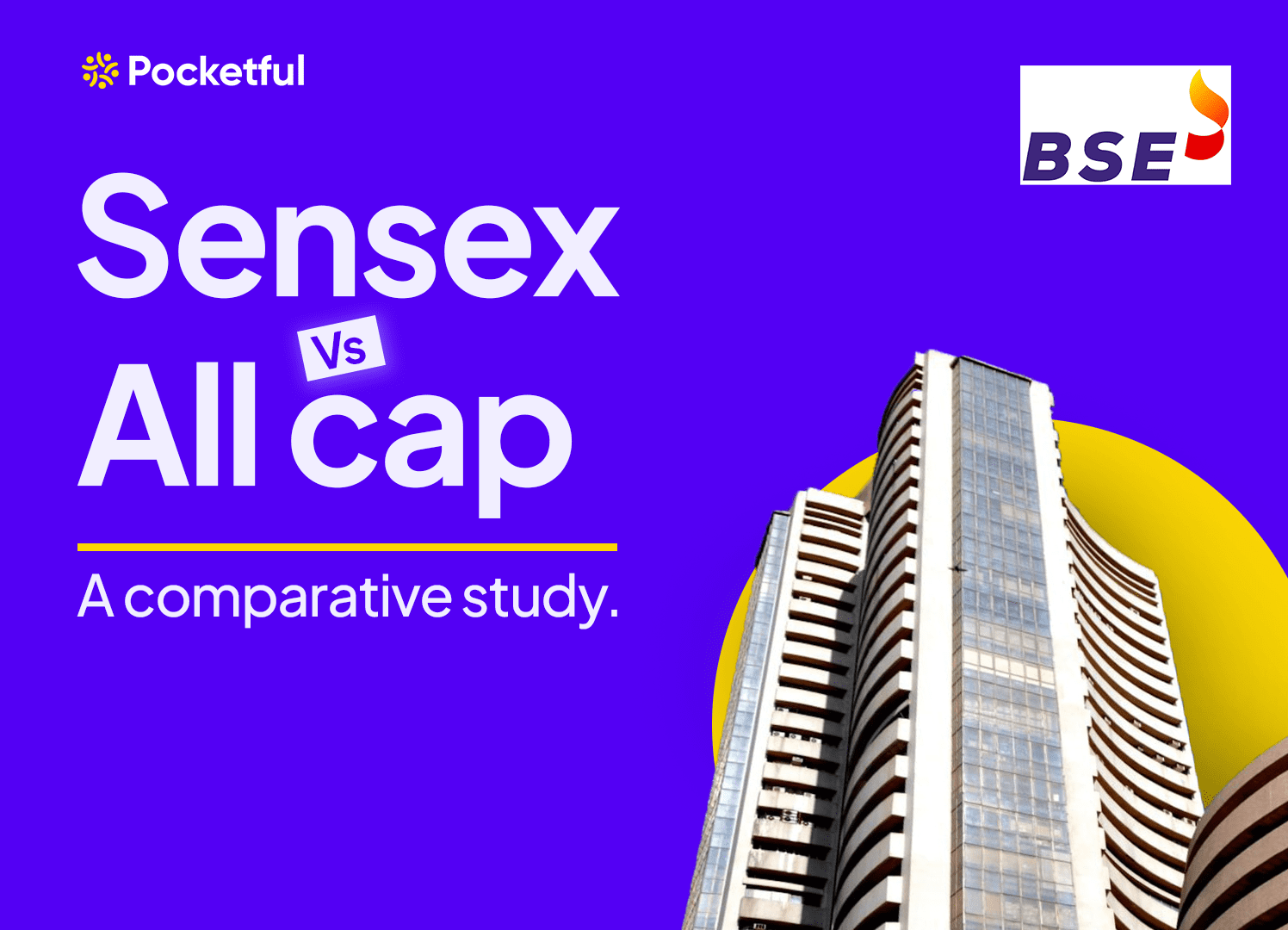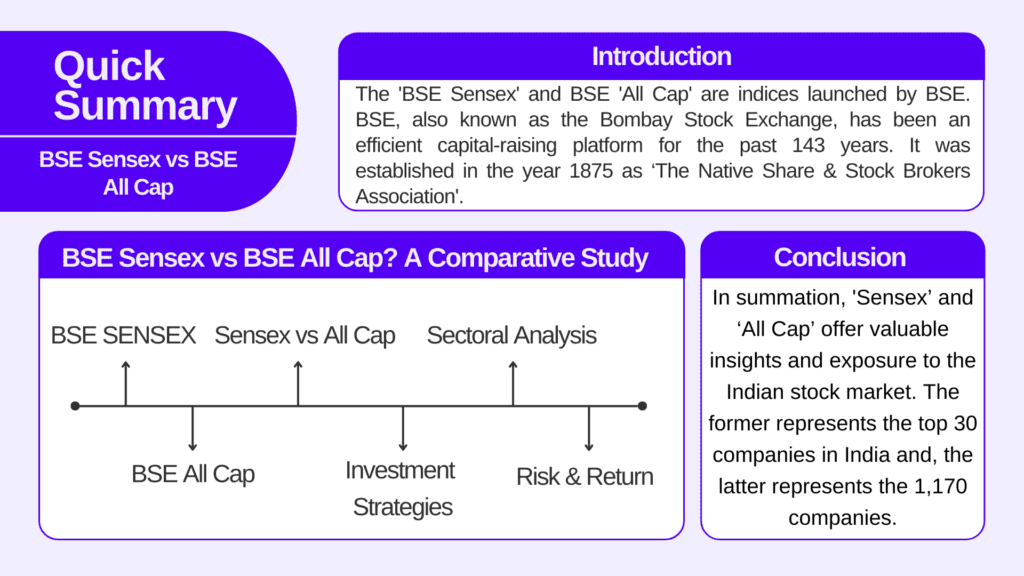| Type | Description | Contributor | Date |
|---|---|---|---|
| Post created | Pocketful Team | Jan-31-24 | |
| Heading optimize | Nisha | Feb-18-25 |

- Blog
- bse sensex vs bse all cap a comparative study
BSE Sensex vs BSE All Cap? A Comparative Study

The ‘BSE Sensex’ and BSE ‘All Cap’ are indices launched by BSE. Before we delve into their analysis, let’s understand what BSE is first.
BSE, also known as the Bombay Stock Exchange, has been an efficient capital-raising platform for the past 143 years. It was established in the year 1875 as ‘The Native Share & Stock Brokers Association’.
In 2017, BSE became the first listed stock exchange in India. BSE aims at providing a transparent market for trading in equity, currencies, debt instruments, derivatives, and mutual funds.
- BSE STAR MF is India’s largest online mutual fund platform, which processes over 27 lakh transactions per month.
- BSE Bond, the transparent and efficient electronic book mechanism process for private placement of debt securities, is the market leader.
BSE’s well-known equity index, ‘The S&P BSE SENSEX’, is India’s most widely used and tracked benchmark index.
Did you know?
BSE is Asia’s first and the fastest Stock Exchange in the world with a speed of 6 microseconds.

BSE SENSEX
The ‘S&P BSE SENSEX’ also known as the “SENSEX” is a benchmark index of the Bombay Stock Exchange. It tracks the performance of the 30 largest and most liquid companies listed on the stock exchange.
You must be wondering what a benchmark is. Well, a benchmark is a widely used standard to compare the returns generated by securities. Index as a benchmark depicts the overall health of the stock market, representing a substantial portion of the Indian market capitalisation.
Consider ‘SENSEX’ as a basket containing the top 30 stocks in terms of size and trading activity. The price fluctuations showcase the combined performance of these companies and give you a general sense of how the Indian stock market is performing.
Its value is calculated based on the free float-adjusted market capitalisation, i.e., the weightage of each company depends on its market cap but is adjusted for the portion of shares available for trading.
BSE All Cap
The ‘BSE All Cap’ is a broader Index launched in 2015 that comprises the S&P BSE Large Cap, the S&P BSE Mid Cap, and the S&P BSE Small Cap. It measures the performance of 1,170 companies that are listed on the stock exchange of different market capitalisation.
Did You Know?
Market Capitalisation = Current Market Price of Shares * Total Number of Outstanding Shares
For example, a company with 1 lakh outstanding shares, each valued at INR 100, would have a market cap of (1 lakh * INR 100) INR 1 crore.
Read Also: How Many Companies Are Listed on NSE & BSE?
Sensex vs All Cap
The “Sensex” tracks the performance of the 30 largest companies and is a basket of India’s blue-chip stocks, whereas “All Cap” tracks the performance of 1,170 companies across all market capitalisation and includes large-cap, mid-cap, and small-cap.
“Sensex” is considered less volatile since its major focus is on large and established companies whose performance tends to be more stable, while “All Cap” can be more volatile because of its broader market exposure and inclusion of small and growth-oriented companies with fluctuations in their performance.
Let’s have a look at the historical returns given by them:
Historical Returns
| Time Frame | Sensex (%) | All Cap (%) |
|---|---|---|
| 1 Year | 17.43 | 28.96 |
| 3 Year | 13.51 | 18.99 |
| 5 Year | 14.44 | 17.05 |
| 10 Year | 12.84 | 15.04* |
Read Also: BSE Sensex vs BSE All Cap? A Comparative Study
Investment Strategies

Choosing between Sensex and All Cap depends completely on your investment goals and risk tolerance. However, below mentioned points will give you a brief overview of strategies:
BSE SENSEX
- Index Investing
Invest in Sensex-based Exchange Traded Funds (ETFs) or Index funds to passively track the performance and growth of the top 30 companies. This investment strategy is low-cost and can be beneficial for investors who wish to start their financial journey.
- Value Investing
Choose undervalued Sensex stocks with strong fundamentals when compared to industry benchmarks and decent prospects. This will help you find some hidden gems.
- Dividend stocks Investing
Go for stocks with a history of consistent dividend pay-outs so that you can generate not only good returns but also regular income.
BSE All Cap
- Growth investing
Target those stocks of ‘All Cap’ that hold high growth potential. You will often find these stocks in mid-cap and small-cap segments. Do proper research to analyse their prospects and financial health.
- Thematic Investing
Invest in stocks based on specific themes such as technology, healthcare, energy or infrastructure, which can give you returns in the long term.
Sectoral Analysis
Understanding the sectoral composition of ‘BSE Sensex’ and ‘All Cap’ can help you measure their exposure to different industries.
- BSE Sensex is dominated by financials with a weightage of around 26% due to the presence of major banks and financial institutions such as HDFC Bank, ICICI Bank, etc. IT and consumer goods such as TCS, HUL, and ITC also hold significant weightage of around 13% to 15%. However, energy, healthcare, etc. represents the smaller portions of the index.
- BSE All cap is more diversified, but financials still hold the top spot with weightage around 18%. However, the weightage is lower than that of Sensex. There is also a stronger presence of mid-cap and small-cap companies. Also, emerging sectors like healthcare, materials, and utilities have greater exposure and high weightage than BSE Sensex.
Refer to the links below for a complete list of the Constituents of both indices:
Risk & Return

‘BSE Sensex’ is generally considered less risky due to its focus on large companies with relatively stable performance and has historically offered lower average returns compared to All Cap due to its focus on mature companies with slower growth.
‘All Cap’ is more volatile because of its broader exposure and also carries a higher risk. Historically, ‘All Cap’ has offered higher returns because mid and small-cap companies carry growth potential. However, remember that historical returns provide no guarantee for future returns.
Combining stocks from various indices or sectors can help you curate a balanced portfolio with stability and returns.
Read Also: A Comparative Study on NSE v/s BSE: Differences, Similarities, and Popularity
Conclusion
In summation, ‘Sensex’ and ‘All Cap’ offer valuable insights and exposure to the Indian stock market. The former represents the top 30 companies in India and, the latter represents the 1,170 companies. Keep in mind that past performance is not indicative of future results. Focus on research and carefully assess your risk appetite before making any investment decisions.
Frequently Answered Questions (FAQs)
What is the difference between BSE Sensex and All Cap?
‘Sensex’ tracks the 30 largest blue-chip companies, and ‘All Cap’ tracks 1,170 companies across all market sizes.
Which index is right for me?
Choosing between the two completely depends on your investment objectives and risk appetite.
Which index is more impacted by economic events?
‘All Cap’ because of its broader exposure, it can be more volatile during short-term economic fluctuations and specific sector-related events.
What are some emerging sectors within the ‘All Cap’ Index?
A few emerging sectors that are currently drawing investors’ attention are renewable energy, electric vehicles, healthcare, artificial intelligence, etc.
Can I invest directly in Sensex or All Cap?
No! Sensex and All Cap are not actual investment vehicles. You can invest in them through Index Funds, ETFs, etc.
Disclaimer
The securities, funds, and strategies discussed in this blog are provided for informational purposes only. They do not represent endorsements or recommendations. Investors should conduct their own research and seek professional advice before making any investment decisions.